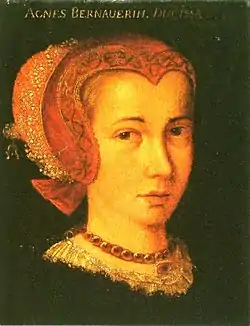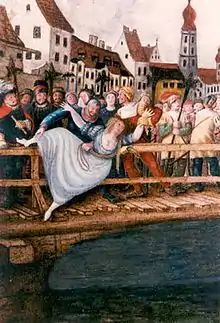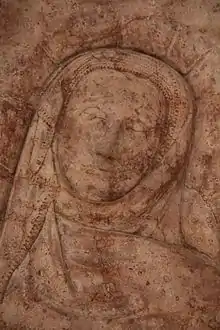
Agnes Bernauer (c. 1410 – 12 October 1435) was the mistress and perhaps also the first wife of Albert, later Albert III, Duke of Bavaria. Because his father, Ernest, ruling Duke of Bavaria at the time, considered this liaison with a commoner unbefitting his son's social standing, he clashed with his son over the matter and finally arranged to have Agnes condemned for witchcraft and drowned in the Danube in 1435. Her life and death have been depicted in numerous literary works, the most well known being Friedrich Hebbel's tragedy of the same name and the folk musical Die Bernauerin by the composer Carl Orff.
Biography
Agnes Bernauer was probably born around 1410; nothing is known of her childhood and youth. She is traditionally considered to have been the daughter of the Augsburg barber surgeon Kaspar Bernauer, whose existence has, however, not yet been proved. Since Ernest's son Albert participated in a tournament in Augsburg in February 1428, it is generally assumed that the latter met Agnes on that occasion and shortly thereafter brought her to Munich.[1] In a Munich tax roll dated 1428, a “pernawin” is listed as a member of his royal household, which is probably a reference to Agnes Bernauer.
In summer 1432 at the latest, Agnes Bernauer was an integral part of the Munich court. She took part in the capture of the robber baron Münnhauser, who had fled to the Old Court in Munich, and she annoyed the Palatine Countess Beatrix, Albert's sister, because of her self-assured manner.[2] It is possible that Agnes and Albert were already married at this point, but there is no concrete evidence of a marriage ceremony. Albert's frequent residence at Blutenburg Castle beginning in 1433 and the sale of two properties in the vicinity to Agnes suggest that the couple lived there together.[3] There is no evidence of joint residence in Albert's county of Vohburg, and there are no known descendants of the couple.[4]
Duke Ernest, Albert's father, was infuriated by the threat to the succession posed by his only son's unsuitable liaison. While Albert was on a hunt arranged by his relative Henry of Bavaria-Landshut, Duke Ernest had Agnes arrested and drowned in the Danube River on 12 October 1435 near Straubing.[5][6] Albert then went to Ingolstadt to Duke Louis VII, but after a few months was reconciled with his father and married Anna of Brunswick in November 1436.[7] The feared military conflict between father and son did not materialize; it is possible that Emperor Sigismund exerted a restraining effect on Albert.
Tributes to her memory

In December 1435, Albert endowed a perpetual mass and an annual memorial celebration in the Straubing Carmelite Cloister in memory of Agnes Bernauer. In 1447 he expanded the endowment in her honor. In 1436, his father had an Agnes Bernauer Chapel erected in the cemetery of St. Peter Straubing, probably to appease his son.[8] It is not known whether Agnes was buried in the Carmelite cloister, which was her wish, or whether Albert arranged for the transfer of her mortal remains to the chapel dedicated to her. In any event, a tombstone of red marble with an almost life-size effigy of Agnes Bernauer was fitted into the floor of the chapel. The relief shows her lying with her head on a large pillow. In her right hand, on which she wears two rings, she holds a rosary, and two small dogs at her feet are there to guide her on her way to the hereafter. It was probably an oversight that the year of her death is incorrectly given there as 12 October 1436.[9]
There are only a few records about the memorial endowments for Agnes Bernauer from the next three centuries. In 1508 a certain Johannes Haberlander was the chaplain responsible for the Bernauer Chapel. For its maintenance and the daily reading of the memorial mass he received 17 pounds in Regensburg pence from the ducal treasury. By 1526 his office had been transferred to a Leonhard Plattner, who received for his services 48 guilders and 4 schilling in Viennese pence.[10] It is not known how long the chaplain's office was maintained. All that is known is that the church trustee Franz von Paula Romayr had the tombstone moved to the wall of the chapel in 1785 in order to protect it from further damage “caused by depredatory footsteps”. The grave itself could not be located when the tombstone was repositioned.[11]
Nevertheless, at the beginning of the 19th century the Agnes Bernauer Chapel became a tourist destination. One newspaper (the Bayerische National-Zeitung) even asserted it as being the only reason to pay a visit to Straubing. The locals were happy to supply visitors with information, not all of it reliable. One concerned reader wrote to the Königlich-Bairische Intelligenzblatt in 1813 that the sexton had informed him that Austrian troops had walked off with the remains of Agnes Bernauer. When the German poet August von Platen inspected the gravestone in 1822, he heard from the female sexton that Agnes and Albert had been switched as infants so that she was actually the duke's daughter and he the son of the barber-surgeon, but that the book which would have confirmed this exchange had been stolen by French soldiers.[12]

After excavations in the Chapel at St. Peter failed to produce any results, the Bernauer biographer Felix Joseph Lipowsky had the Carmelite cloister grounds searched in 1897 for evidence of her grave. He found in the cloister archives a note indicating that the grave was in the former Nicholas chapel of the cloister church, but this chapel had been converted to a sacristy after 1692 and the vault underneath filled in. Lipowsky could only assume that her remains were reburied elsewhere during the reconstruction work. Despite subsequent searches, her grave remains undiscovered.[13]
The Bavarian king Ludwig I, who had himself visited the Agnes Bernauer Chapel in 1812 when he was crown prince and later dedicated a poem to Agnes, saw to it that at least the masses for Agnes and Albert were again read in the Carmelite church. Since 1922, only one memorial mass is celebrated annually, due to financial limitations; it is paid for by the Bavarian government.
In 2013 at the Blutenburg Castle there was erected the Sculpture of Agnes Bernauer with Albert III, Duke of Bavaria by Joseph Michael Neustifter. The memorial was funded by Ursula und Fritz Heimbüchler.[14]
In connection with the 1200th anniversary of the Obermenzing / Untermenzing (former Menzing) districts of Munich, on the stage belonging to the Temple "Leiden Christi" next to the Blutenburg Castle, in 2017 took place the premiere of the musical performance "Agnes or the Secret of the Blutenburg Castle", which presented a fantastic version of the fate of Agnes Bernauer.[15]
Adaptations
Albert and Agnes' tragic love story has long been a staple of folk songs, and over the centuries many new literary and musical versions have been created.
- Christian Hoffmann von Hoffmannswaldau: Liebe Zwischen Hertzog Ungenand und Agnes Bernin, Poem, 1680
- Joseph August Graf von Toerring: Agnes Bernauer, Vaterländisches Schauspiel, Play, 1780
- Georg Joseph Vogler (Music), Carl Theodor Traitteur (Libretto): Albert der Dritte von Bayern, Singspiel, UA München 1781
- Franz Gleißner (Music): Agnes Bernauerin, Melodrama, probably after Toerring, 1781, UA München 1790
- Ignaz von Seyfried (Music, Karl Ludwig Giesecke (Libretto): Agnes Bernauerin (burlesque), 1798
- Karl August Krebs (Music): Herzog Albrecht, Opera, UA Hamburg 8 October 1833 (revised version: Dresden 1858 as Agnes Bernauer)
- King Ludwig I of Bavaria: An Agnes Bernauerin, Poem
- Adolf Böttger: Agnes Bernauer, Drama, 1846
- Melchior Meyr: Herzog Albrecht, Drama, 1852
- Friedrich Hebbel: Agnes Bernauer - Ein deutsches Trauerspiel in fünf Aufzügen, Drama, 1855
- Otto Ludwig, several versions of a drama, 19th century
- Martin Greif: Agnes Bernauer oder der Engel von Augsburg, Drama, 1894
- Eugen Hubrich: Die Agnes Bernauer zu Straubing, Open-air Play, 1935. From 1952 to 1989, the play was adapted several times for the Agnes Bernauer Festival in Straubing. Until 1963, Hubrich made the changes himself.
- Hans Karl Meixner, Agnes Bernauer: Ein Leben voll Leid und Liebe: Roman. Reutlingen: Enßlin & Laiblin, Novel, 1937.
- Carl Orff: Die Bernauerin - Ein bairisches Stück, Folk Musical, 1944, UA Stuttgart 1947
- Raymond Bernard (Director), Bernard Zimmer (Screenplay), Joseph Kosma (Music): Le Jugement de Dieu, Historical Movie, 1949–51
- Michel Boisrond (Director), Jacques Prévert (Screenplay), France Roche (Screenplay), Maurice Jarre (Music): Famous Love Affairs, Anthology film, 1961, with Brigitte Bardot as Agnes Bernauer
- Karl Ristikivi. Nõiduse õpilane (The Student of Witchcraft). A novel in Estonian, 1967. Agnes Bernauer is one of the female main characters, causing political murder of the main character who is researcher and physician in the court of Dukes Ernst and Albrecht.
- Franz Xaver Kroetz: Agnes Bernauer, Play, 1976
- Manfred Böckl: Agnes Bernauer. Hexe, Hur' und Herzogin. Novel, 1993 ISBN 3-924484-63-5
- Thomas Stammberger und Johannes Reitmeier: Agnes Bernauer - Ein Historienspiel in fünfzehn Bildern, Open-air Play, 1995 (2003 and 2007 revised by Johannes Reitmeier)
- Richard Wunderer: Agnes Bernauer und ihr Herzog. Rosenheimer, Rosenheim 1999 ISBN 3-475-52940-8
Notes
- ↑ On Agnes Bernauer's origins see Marita Panzer's discussion of Kaspar Bernauer in Agnes Bernauer, pp. 11–15; on the tournament see Chronik des Hektor Mülich 1348–1487 in: Die Chroniken der schwäbischen Städte. Augsburg. vol. 3, Vandenhoeck & Ruprecht, Göttingen 1965, p. 70 (following Alfons Huber, Agnes Bernauer im Spiegel der Quellen, p. 13). Referring to the meagre evidence for Agnes' origins in Augsburg, Claudia Märtl in Straubing, p. 154, assumes that she was a servant at the Munich court and there aroused the interest of Albert. Panzer, Agnes Bernauer, p. 36f. and p. 170, comment. 32, rejects this supposition.
- ↑ On Agnes Bernauer in München see 1) Stadtarchiv München, Steueramt Nr. 584, fol. 42 r (following Marita Panzer, Agnes Bernauer, p. 36f); 2) Stadtarchiv München, Kammerrechnung Stadt München 1431/32, fol. 50 v (following Alfons Huber, Agnes Bernauer im Spiegel der Quellen, p. 13, cf. Panzer, Agnes Bernauer, p. 38f; 3) Stadtarchiv München, Kammerrechnung Stadt München 1431/32, fol. 51 r (following Alfons Huber, Agnes Bernauer im Spiegel der Quellen, p. 15, cf. Panzer, Agnes Bernauer, p. 41.
- ↑ Deed of purchase from the parish of Aubing. In: Ernst Geiß: Beitrag zur Geschichte der Agnes Bernauer, in: Oberbayerisches Archiv. vol. 7, 1846, p. 303f. (following Alfons Huber, Agnes Bernauer im Spiegel der Quellen, p. 16). See Panzer, Agnes Bernauer, p. 43f. and the reference to Johannes Erichsen: Umrisse Blutenburger Geschichte, in: Claus Grimm (ed.): Blutenburg. Beiträge zur Geschichte von Schloß und Hofmark Menzing. Haus der Bayerischen Geschichte, München 1983, p. 26ff.
- ↑ Gottfried Horchler argues against a marriage ceremony in Agnes Bernauer in Geschichte und Dichtung. 1. Teil, Attenkofer, Straubing 1883, pp. 11–14. Sigmund Riezler argues for a secret marriage known only to a few insiders, see Agnes Bernauerin und die bairischen Herzoge in: Sitzungsberichte der Königlich Bayerischen Akademie der Wissenschaften. Historische Classe. Jahrgang 1885, pp. 294–301. The children who are repeatedly mentioned as theirs, Sibilla Neufarer and Albert vom Hof, cannot have had Agnes Bernauer as their mother: Sibilla's father was Albert III, but she married for the second time already in 1444 and already had a son at that time. Albert vom Hof was an illegitimate son of Albert IV and was born only in 1447. Cf. Panzer, Agnes Bernauer, pp. 52–56.
- ↑ Andreas von Regensburg: Chronica de principibus terrae Bavarorum, in: Georg Leidinger (ed.): Sämtliche Werke. Rieger, München 1903, p. 583f. (written before 1444; following Alfons Huber, Agnes Bernauer im Spiegel der Quellen, p. 55).
- ↑ Chisholm, Hugh, ed. (1911). . Encyclopædia Britannica. Vol. 3 (11th ed.). Cambridge University Press.
- ↑ Financial records concerning events up to the marriage of Albert and Anna: 1) Kammerrechnung Stadt München 1435/36, fol. 45 r; 1434/35 (following Alfons Huber, Agnes Bernauer im Spiegel der Quellen, p. 26). 2) Kammerrechnung Stadt München 1434/35 (following Alfons Huber, Agnes Bernauer im Spiegel der Quellen, p. 26). 3) Kammerrechnung Stadt München 1435/36, fol. 57 (following Alfons Huber, Agnes Bernauer im Spiegel der Quellen, p. 32, p. 40). 4) Kammerrechnung Stadt München 1435/36, fol. 59 v (following Alfons Huber, Agnes Bernauer im Spiegel der Quellen, p. 44). 5) Kammerrechnung Stadt München 1435/36, fol. 49 v; Kammerrechnung Stadt München 1436/37, fol. 56 v (following Alfons Huber, Agnes Bernauer im Spiegel der Quellen, p. 47f.).
- ↑ Ducal documents dated 1435: 1) Bayerisches Hauptstaatsarchiv, Fürstensachen IV, fol. 213–214 (following Alfons Huber, Agnes Bernauer im Spiegel der Quellen, p. 24f.); 2) Fürstensachen IV, fol. 300–301 (following Alfons Huber, Agnes Bernauer im Spiegel der Quellen, pp. 26–32), see also Marita Panzer, Agnes Bernauer, pp. 89–92; 3) Fürstensachen IV, fol. 307 (following Alfons Huber, Agnes Bernauer im Spiegel der Quellen, p. 32, p. 38).
- ↑ )For a description and illustration of the tombstone see Marita Panzer, Agnes Bernauer, pp. 118–121.
- ↑ On the church visitation of 1508: Paul Mai, Marianne Popp: Das Regensburger Visitationsprotokoll von 1508. In: Beiträge zur Geschichte des Bistums Regensburg. vol. 18, 1984, p. 48 (following Alfons Huber, Agnes Bernauer im Spiegel der Quellen, p. 66f.). On the church visitation of 1526: Paul Mai: Das Regensburger Visitationsprotokoll von 1526. In: Beiträge zur Geschichte des Bistums Regensburg. vol. 21, 1987, p. 73 (following Alfons Huber, Agnes Bernauer im Spiegel der Quellen, S. 74).
- ↑ On the repositioning of the tombstone see the correspondence between Romayr and the Elector in Gottfried Horchler: Agnes Bernauer in Geschichte und Dichtung. 1. Teil, Attenkofer, Straubing 1883, p. 44f. On the missing grave: Franz Sebastian Meidinger: Historische Beschreibung der kurfürstl. Haupt- und Regierungs-Städte in Niederbaiern Landshut und Straubing. Hagen, Landshut 1787 (following Alfons Huber, Agnes Bernauer im Spiegel der Quellen, p. 128, and Marita Panzer, Agnes Bernauer, p. 121f.).
- ↑ On the chapel and its visitors see 1) Die Agnes Bernauer-Kapelle in Straubing in: Bayerische National-Zeitung. No. 96, 1836 (following Alfons Huber, Agnes Bernauer im Spiegel der Quellen, p. 151f.); H. H.: Anfrage, die Reliquien der Agnes Bernauerin betreffend in: Königlich-Bairisches Intelligenzblatt. No. 24, 1813, col. 194–198 (following Alfons Huber, Agnes Bernauer im Spiegel der Quellen, p. 139f.); 3) Die Tagebücher des Grafen August von Platen. Aus der Handschrift des Dichters herausgegeben. Vol. 2, Cotta, Stuttgart 1896, p. 553 (following Alfons Huber, Agnes Bernauer im Spiegel der Quellen, p. 145f.).
- ↑ On the excavations in the Carmelite cloister: 1) Anniversar-Register im Archiv des Karmelitenklosters für 1447, p. 29. In: Felix Joseph Lipowsky: Agnes Bernauerinn historisch geschildert. Lentner, München 1801, p. 125 (following Alfons Huber, Agnes Bernauer im Spiegel der Quellen, p. 55).2) Joseph Scherer: Die Reliquien der Agnes Bernauerin betreffend. In: Teutoburg. Zeitschrift für die Geschichte, Läuterung und Fortbildung der deutschen Sprache. Heft 2, 1815 (following Alfons Huber, Agnes Bernauer im Spiegel der Quellen, p. 140).3) Other speculations about the location of the grave are in Marita Panzer, Agnes Bernauer, pp. 122–126.
- ↑ "Schloss Blutenburg: Skulpturenpark". www.blutenburg.de.
- ↑ "Agnes or the Secret of the Blutenburg Castle". www.feeria.de.
References
- Werner Schäfer: Agnes Bernauer und ihre Zeit. Nymphenburger, München 1987 ISBN 3-485-00551-7
- Werner Schäfer: Agnes Bernauer. Geschichte - Dichtung - Bild. Attenkofer, Straubing 1995 ISBN 3-931091-02-3
- Hans Schlosser: Agnes Bernauerin (1410–1435). Der Mythos von Liebe, Mord und Staatsräson, in: Zeitschrift der Savigny-Stiftung für Rechtsgeschichte, Germanistische Abteilung, 122. Band (2005), Wien-Köln-Weimar, Seiten 263-284
- Richard Utz: Medievalism: A Manifesto (Bradford, UK: ARC Humanities Press, 2017), chapter 3: "Residual Medievalisms in Eastern Bavaria."
External links
- (in German) Online Text of Hoffmannswaldau's poem at Projekt Gutenberg-DE
- (in German) Online Text of King Ludwig's poem
- (in German) Online Text of Hebbel's play
- (in German) Agnes Bernauer Festspiele in Vohburg
- (in German) the Agnes Bernauer Canoe trail on the Danube from Vohburg to Kelheim